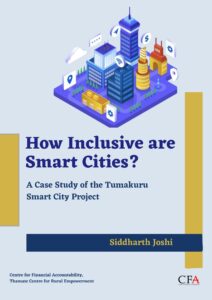 The Smart City Mission was launched by the Ministry for Urban Development in 2015 under which 100 cities were to be selected across the country. The mission was marked by several departures from earlier urban development programmes. The selection of cities, instead of being left to the states or being decided based on some objective criteria, was to be arrived at through a competitive process where the contending cities were to be scored on a detailed Smart City Proposal after extensive citizen engagement. The selected cities were required to implement the proposed projects through a Special Purpose Vehicle (SPV) (Public Limited Company) with powers of the Executive officer and the Elected Council of the Urban Local Body delegated to the Managing Director and the Board of Directors of the SPV. The Smart City Proposals were required to adopt an area-based approach where a large part of the project funds were to be directed to a specific area.
The Smart City Mission was launched by the Ministry for Urban Development in 2015 under which 100 cities were to be selected across the country. The mission was marked by several departures from earlier urban development programmes. The selection of cities, instead of being left to the states or being decided based on some objective criteria, was to be arrived at through a competitive process where the contending cities were to be scored on a detailed Smart City Proposal after extensive citizen engagement. The selected cities were required to implement the proposed projects through a Special Purpose Vehicle (SPV) (Public Limited Company) with powers of the Executive officer and the Elected Council of the Urban Local Body delegated to the Managing Director and the Board of Directors of the SPV. The Smart City Proposals were required to adopt an area-based approach where a large part of the project funds were to be directed to a specific area.
The understanding of the city which underpins the conceptualization of the Smart City Mission is one, which is devoid of class, caste and gender-based inequalities. The process prescribed for arriving at the Smart City Proposal, including the choice of areas for area-based development, did not take into account the differential power of various social groups in any given city, and the very real possibility of the proposed projects being skewed in the favour of dominant social groups, leaving out the much more urgent needs of the urban marginalized communities.
In Karnataka, 11 cities entered the first round of the City Challenge. The selection of these 11 cities did not entail any ward-level public consultations as required by the Guidelines for the Mission. Tumakuru was the smallest (population-wise) city to be shortlisted in this first round of the Challenge. The process of citizen engagement to formulate the Smart City Proposal was largely conducted through online mediums and thus left out a large section of the urban deprived communities. This exclusion was reflected both in terms of the themes chosen for the Proposal as well as the choice of areas for area-based development. Instead of focusing on basic amenities for under-served areas predominantly inhabited by marginalized communities, the proposal chose to focus on already well-endowed areas inhabited by dominant communities.
When the Tumakuru Smart City Proposal was rejected in Round 1 for low population and area coverage, among other things, newer areas which had higher concentration of marginalized communities were added, but eventually they received very low project investments. For example, Ward 19 which contributed 13.8% to the area coverage (excluding Amanikere lake area) and 20% to the population coverage under the successful Round 2 Smart City Proposal, with 30% Dalit population, received only 0.31% of project expenditure under area-based development component.
When it came to actual implementation of the Smart City Mission, political opposition to thoroughgoing delegation of powers to the SPV yielded only a limited and staggered delegation of administrative and financial powers of approval and sanction. In spite of only a limited delegation of powers and despite representation of only a few elected corporators of the City Council (including the Mayor and Deputy Mayor), the SPV was perceived as a parallel body operating in parallel to and outside the purview of the City Corporation leading to friction between the two institutions.
Owing to the long gap (1.5 years) between the drafting of the Smart City Proposal and the selection of Tumakuru as a Smart City, the infeasibility of few proposed projects at the implementation stage and changes in the scope and extent of projects because of demands made from various quarters, there was considerable divergence between the selected proposal and the final set of projects being implemented. Several wards which are outside the area-based development (ABD) wards received non-significant levels of investment under the Mission and few wards which were part of the ABD area, received negligible investments. The initial take-off was slow in Tumakuru because of unfamiliarity of the Project Management Consultants with the ‘land and its language’ and absence of a full-time CEO and MD for the SPV. The pressure from Delhi to show quick progress led to front-loading of smaller projects. Owing to question marks over the future of the SPV, all assets created under the Mission have been transferred to the City Corporation, which would bear the responsibility to maintain them. Since increase in Corporation revenues are uncertain, the City is already facing increase in general property tax and special purpose cesses. Bulk of the project spending is accounted for by road development and lake development works, while the basic needs and necessities of the urban-deprived communities have been ignored.
Read the full report here: Tumakuru SCM Report Dec 2021
Centre for Financial Accountability is now on Telegram. Click here to join our Telegram channel and stay tuned to the latest updates and insights on the economy and finance.
